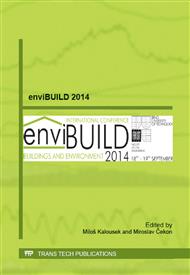[1]
M. Benža et al: Folk architecture and urban planning of rural settlements in Slovakia. Academic Electronic Press, s. r. o. for National Conservation and Landscape Center, Slovak Republic, 1998, p.360. 80-88880-23-8.
Google Scholar
[2]
J. Lacika: 1000 religious monuments in Slovakia. The most beautiful religious buildings. Ikar, Slovakia, 2012, ISBN: 9788055128528.
Google Scholar
[3]
M. Björling, H. Stymne, C.A. Boman: The Indoor Climate of a Naturally Ventilated Church. Proceedings of Healthy Buildings 2009, USA, (2009).
Google Scholar
[4]
E. Arumägi, T. Kalamees, T. Broström: Indoor climate in a naturally ventilated unheated medieval church in Harju-Risti, Estonia. 10th REHVA World congress Clima, Turkey, (2010).
Google Scholar
[5]
A.S. Hussein, H. El-Shishiny: Influences of wind flow over heritage sites: a case study of the wind environment over the Giza Plateau in Egypt. Environ. Modell. Softw. 24 (3), 389-410, (2009).
DOI: 10.1016/j.envsoft.2008.08.002
Google Scholar
[6]
F. Monforti, R. Bellasio, R. Bianconi, G. Clai, G. Zanini: An evaluation of particle deposition fluxes to cultural heritage sites in Florence, Italy. Sci. Total Environ. 334-335, 61-72, (2004).
DOI: 10.1016/j.scitotenv.2004.04.030
Google Scholar
[7]
H. -J. Steeman, M. Van Belleghem, A. Janssens, M. De Paepe: Coupled simulation o heat and moisture transport in air and porous materials for the assessment of moisture related damage. Build. Environ. 44 (10), 2176-2184, (2009).
DOI: 10.1016/j.buildenv.2009.03.016
Google Scholar
[8]
M. Kalousek, O. Šikula: CFD simulation of ventilated air cavity. Building Simulation and Environmental Engineering 2008, 5. conference, Czech Republic, (2008).
Google Scholar
[9]
T. Renčko: Theoretically justified structural restoration of historic buildings. Dissertation work. Košice: Technical University in Košice, Civil Engineering Faculty, (2013).
Google Scholar
[10]
STN 73 0540-2. Thermal protection of buildings. Thermal performance of buildings and components. Part 2: Functional requirements. (2012).
Google Scholar
[11]
STN 73 0540-3. Thermal protection of buildings. Thermal performance of buildings and components. Part 3: Properties of environments and building products. (2012).
Google Scholar
[12]
STN EN ISO 13790/NA. Energy performance of buildings. Calculation of energy use for space heating and cooling (ISO 13790: 2008). National Annex. (2010).
DOI: 10.1016/j.enbuild.2006.06.007
Google Scholar
[13]
STN EN ISO 10211. Thermal bridges in building construction. Heat flows and surface temperatures. Detailed calculations. (2008).
DOI: 10.3403/30143206u
Google Scholar
[14]
ANSYS Inc. CFX 12. 1. Tutorials, Ansys CFX, Release 12. 1.
Google Scholar
[15]
T. Renčko, A. Sedláková: CFD Model of an Underfloor Air Cavity Created from Special Fittings and its Verification Using a Laboratory Model. Advanced Materials Research. Vol. 899, 235-240, (2014).
DOI: 10.4028/www.scientific.net/amr.899.235
Google Scholar


